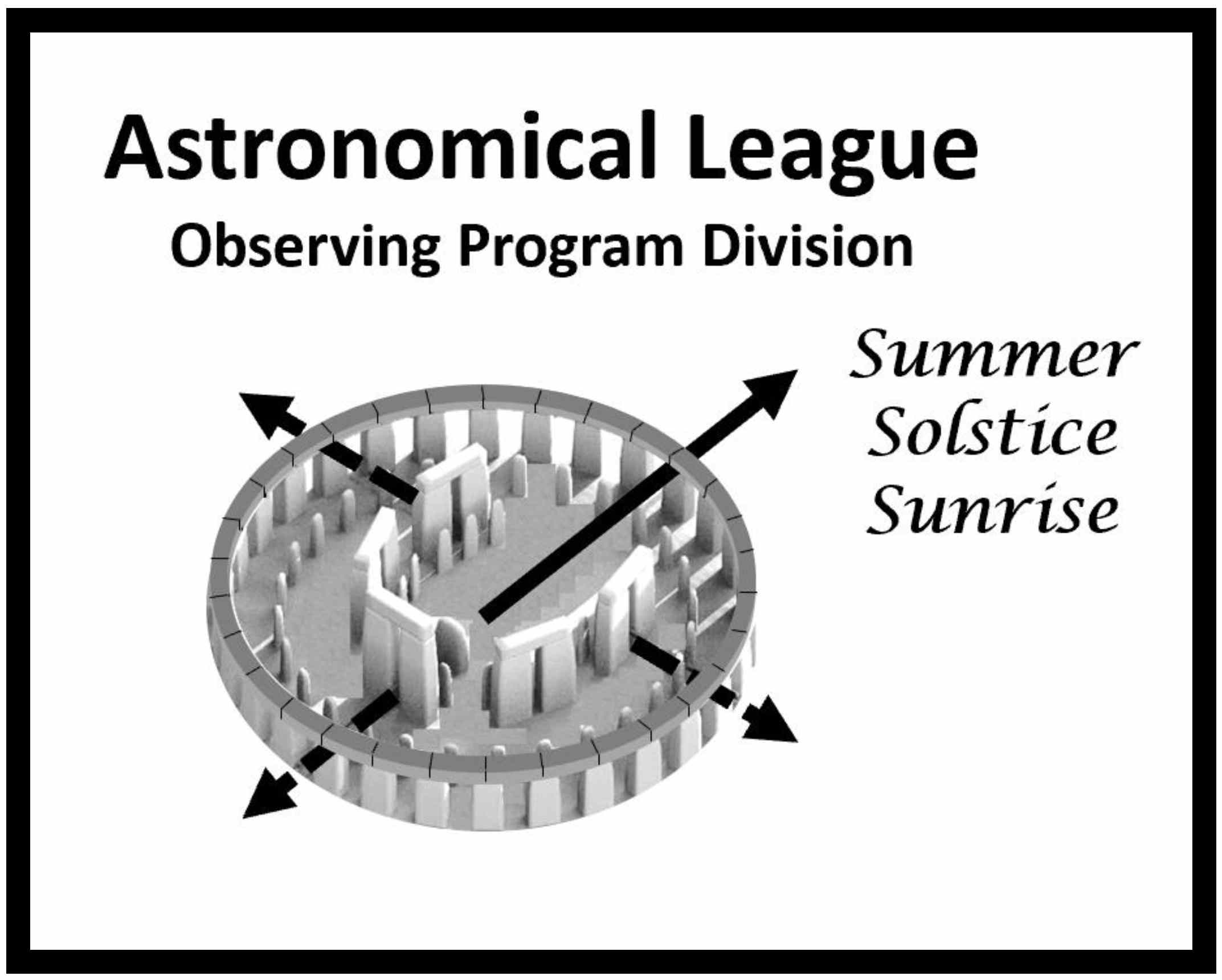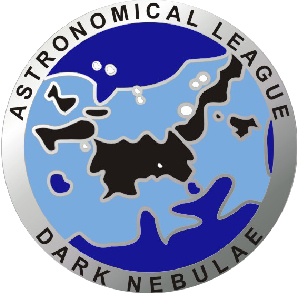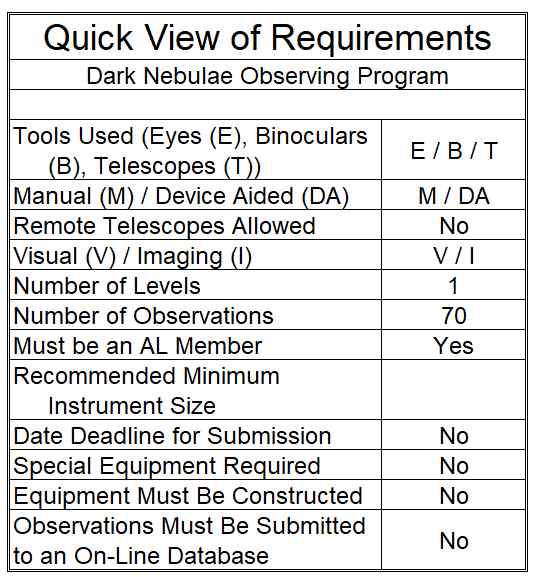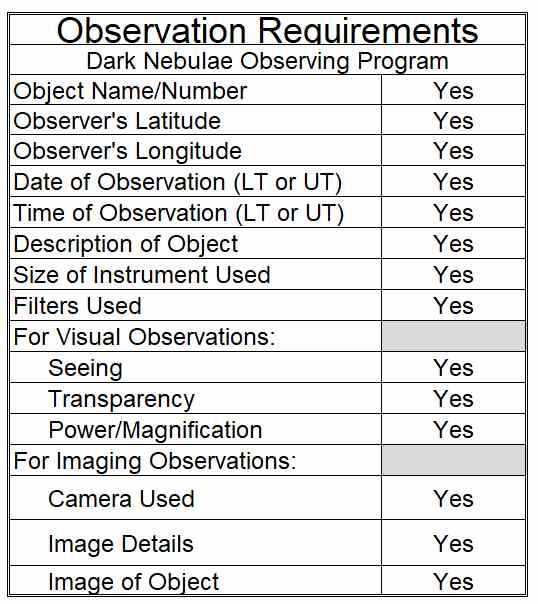Dark Nebula Observing Program Coordinator:Kathy Machin |
  |
Introduction
Dark nebulae were once thought to be holes in the Milky Way. This viewpoint changed as astronomers such as E.E. Barnard started serious study of the dark areas and photography was developed as a useful tool to study the heavens. These pioneers discovered that dark nebulae were not holes in the Milky Way but obscuring interstellar dust clouds blocking our view. These dust clouds may be small, dusty star-forming regions, or may be portions of larger dark lanes of galactic dust. Other dusty spiral galaxies clearly show similar dark lanes and patches.
Background InformationObserving the Objects:Dark nebulae are among the most difficult objects for an observer to search out. Although many are large enough to be visible to the unaided eye or as binocular objects, they may be difficult because transparent skies away from city lights are needed. The dark nebulae “holes” are not visible unless the Milky Way itself is clearly present. Identification is sometimes challenging. Some large dark nebulae include smaller, darker patches with separate IDs which may cause confusion. Log only the objects that you can distinguish as separate areas. For example, the Stem of the Pipe Nebula has four Barnard dark nebulae within its area. Only log the darker concentrations of the individual Barnard objects if you can distinguish them as separate darker patches. It is very possible that on some nights you will see the whole, but not the parts or vice versa. |
 |
The objects on this list will require equipment ranging from the unaided eye to a telescope. Tripod-mounted binoculars or a small (4-6”) rich field telescope will be ideal for finding many dark nebulae. Some of the smaller dark nebulae may require the smaller field and light gathering of an 8” or larger telescope. Larger telescopes may be needed to see some of the more difficult optional dark nebulae. You do not need a telescope larger than 8” to complete this observing project if your skies are dark and transparent and you choose your targets carefully. You may need to use more than one source to locate and identify the nebulae.
The list includes objects from Barnard (B), Lynds Dark Nebula (LDN), and other catalogs. The definitive identification of the Barnard objects is E.E. Barnard’s Photographic Atlas of the Milky Way. The Georgia Institute of Technology has made this valuable resource available online. This website is at: https://exhibit-archive.library.gatech.edu/barnard/
Not all the Barnard objects are in the Barnard Photographic Atlas; a few, such as B33 (the Horsehead), are not.
Dark nebulae vary in how much they obscure the background stars. Many dark nebulae have a Lynds opacity number associated with them. The Lynds opacity scale is based on Palomar blue and red photographic plates rather than visible light but does provide a method of describing the apparent density of dark nebulae. In this 1-6 scale, the most opaque dark nebulae are classed as opacity 6, and the least opaque as opacity 1. For example, on the Lynds opacity scale: B92 is classed as an opacity 6, B86 is a 5, B361 is a 4, B111 is a 3, B138 is a 2, and B144 is a 1. In this project, you are to estimate the opacity of the dark nebulae you observe. Use an opacity scale of 1-6, with 6 being the darkest. Estimating the opacity of various dark nebulae will give you an additional way to describe and compare them.
Requirements and Rules
This certification is available to members of the Astronomical League, either through their local astronomical society or as members at large. If you are not a member and would like to become one, check with your local astronomical society, search for a local society on the Astronomical League Website, or join as a Member-at-Large .
Visual Observations:
|
 |
Imaging:
- You must image 70 dark nebulae. There are 35 required objects on this list that you must image. Choose 35 others from the list for a total of 70 to receive your pin/certificate. Please see the link to the lists below.
- The use of publicly available “remote” telescopes controlled via an internet connection is not allowed. Delegation of image acquisition is not acceptable.
- “Go-to” telescopes are allowed.
- Imaged dark nebulae must be identified by means of an overlay, companion sketch or other method to clearly identify the dark nebulae on the image(s). This is particularly important in cases where the dark nebula may be difficult to clearly identify on the image or more than one dark nebula is present.
- Keep a log recording your imaging including:
- Object name and number
- Date and time of the imaging (local or UT)
- Latitude and longitude of your imaging location
- Seeing and transparency
- Filters used (if any)
- Telescope/optics used including aperture and focal ratio
- The camera/CCD used, exposure times, film types, image software, number of stacked images, and other information relevant to the image production must also be provided
- Include an estimate of how opaque (dark) the dark nebula is compared to other dark nebula and the surrounding Milky Way. This required estimate of opacity should be made on a scale of 1-6 with 6 being the most opaque.
- Complete an index with the object imaged and the page number of the image.
- If the program is completed solely by imaging, an ”i” will be added to your certificate number.
Combined Visual and Imaging:
Observers may combine imaging and visual observations provided that the logging requirements for each type of activity meet the individual requirements above. The Imaging Certificate will only be issued when 100% of the objects are observed through imaging.
Please check with the Dark Nebula Observing Program Coordinator if you have any questions about the requirements.
Submitting for Certification
| To receive your Dark Nebulae Observing Program certificate and pin, send copies of your observations or images along with the completed Submission Form (or equivalent) to the Dark Nebula Observing Program Coordinator.
Be sure to include: your name, mailing address, email address, phone number, society affiliation, and to whom the certification should be sent. Send only COPIES of your observations or images in case they get lost in the mail. Please avoid sending prints or slides unless you do not require them back. Images or observations in electronic format may be forwarded by any convenient means. This may include mailing a storage device such as a CD or flash drive, or ‘posting’ on the web. Please check with the Observing Program Coordinator if you have any questions on how to transfer your images or observations for review. Material sent for review will not be returned unless return postage is included. |
 |
Dark Nebulae Observing Program Chair:
Kathy Machin
4845 N Smalley Ave.
Kansas City, MO 64119
E-mail: Nihcamk@gmail.com
Upon verification of your submission and of your active membership in the Astronomical League, your recognition (certificate, pin, etc.) will be sent to you or to the awards coordinator for your society, as you specified. Your name will also appear in an upcoming issue of the Reflector magazine and in the Astronomical League’s online database. Congratulations. Good luck with your next observing challenge.
Links:
- Required Object List: Download as PDF
- Optional Object List: Download as PDF
- Sample Log Sheets: Download as PDF
- Submission Form: Download as PDF



